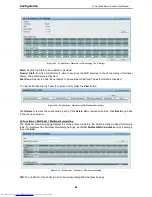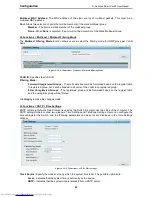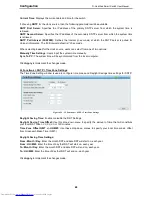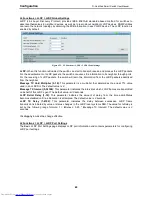
Configuration
D-Link Web Smart Switch User Manual
3
3
4
4
Similar as Voice VLAN, Auto Surveillance VLAN is a feature that allows you to automatically place the video
traffic from D-Link IP cameras to an assigned VLAN to enhance the IP surveillance service. With a higher
priority and individual VLAN, the quality and the security of surveillance traffic are guaranteed. The Auto
Surveillance VLAN function will check the source MAC address on the incoming packets. If it matches
specified MAC address, the packets will pass through switch with desired priority.
VLAN > Auto Surveillance VLAN
Figure 4.35 – VLAN > Auto Surveillance VLAN
Auto Surveillance VLAN Global Settings:
Auto Surveillance VLAN:
Select to enable or disable Auto Surveillance VLAN. The default is
Disabled.
VLAN ID:
By default, the VLAN ID 4094 was created as auto surveillance VLAN. You also can create
another Auto Surveillance VLAN after
Enabled
is selected in
Auto Surveillance VLAN
.
Priority:
The 802.1p priority levels of the traffic in the Auto Surveillance VLAN. The possible values are
Highest, High, Medium
and
Low
.
Tagged Uplink/Downlink Port:
Specifies the ports to be tagged uplink port or downlink port for the Auto
Surveillance VLAN.
Click
Apply
to implement the changes.
User-defined MAC Settings:
Component Type:
Auto Surveillance VLAN will automatically detect D-Link Surveillance Devices by default.
There are another five surveillance components that could be configured to be auto-detected by the Auto
Surveillance VLAN. These five components are
Video Management Server (VMS), VMS client/Remote
viewer, Video Encoder, Network Storage
and Other
IP Surveillance Devices
.
Description:
Here to input the description for the component type.
MAC/OUI:
You can manually create an MAC or OUI address for the surveillance component. The maximum
number of user defined MAC address is 5. System will auto generate an ACL profile (Profile ID: 53) for all the
Auto Surveillance VLAN rules.
















































